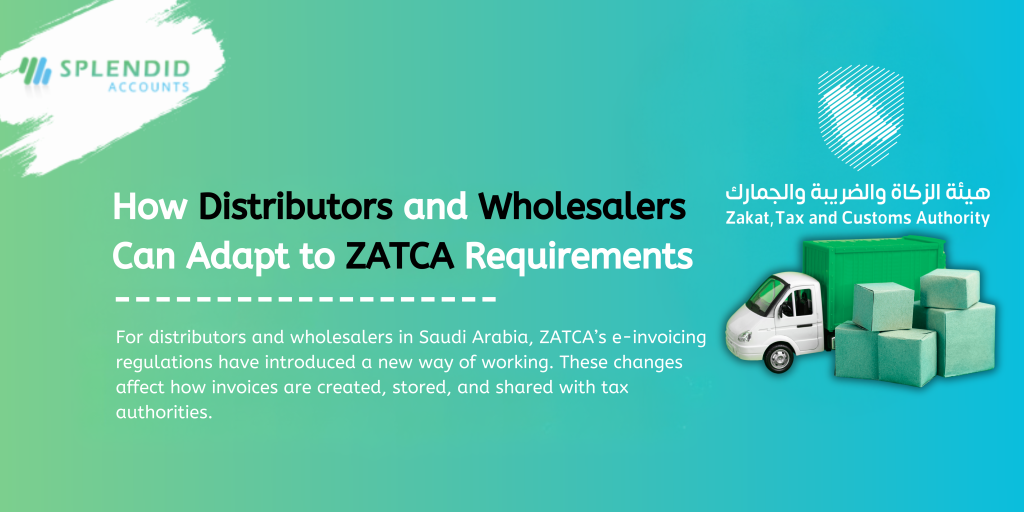
For distributors and wholesalers in Saudi Arabia, ZATCA’s e-invoicing regulations have introduced a new way of working. These changes affect how invoices are created, stored, and shared with tax authorities. If your business deals with bulk sales, frequent transactions, and multiple buyers, adapting to these requirements is essential to keep your operations smooth and compliant.
This guide will help you understand exactly what steps to take—without the technical jargon.
1. Choose the Right Software
The first step is to get software that meets ZATCA’s requirements. Not every invoicing or accounting tool is approved, so you’ll need one that:
- Creates invoices in the right digital format
- Automatically includes all required invoice fields (like VAT breakdown, buyer and seller details)
- Adds special elements like a QR code, UUID, and cryptographic stamp
- Can be connected directly to ZATCA’s system for real-time invoice sharing (especially important in the second phase)
Using the right software means you don’t have to manually upload anything or worry about formatting issues—it’s all done for you in the background.
✅ Tip: If your current system isn’t compatible, switch to a ZATCA-enabled solution or integrate a compliant module with your ERP.
2. Clean and Organize Your Customer and Product Data
To create accurate e-invoices, your system must have complete and correct data. Make sure:
- Each customer record includes full name, VAT ID (if applicable), address, and contact info.
- Your products are listed with clear names, correct VAT rates, unit prices, and units of measurement.
- Discounts and delivery charges are clearly mentioned and applied consistently.
Incorrect data leads to invoice rejections, which can cause delays, compliance issues, or even fines.
✅ Pro Tip: Assign someone on your team to regularly audit customer and product information.
3. Automate Your Invoice Creation
As a distributor or wholesaler, you likely generate a large number of invoices daily. Manual invoice creation not only wastes time but increases the risk of errors.
A good invoicing system should automatically:
- Generate invoices when orders are confirmed
- Apply correct VAT rates
- Add required ZATCA fields (QR code, etc.)
- Send the invoice directly to the buyer and ZATCA’s portal
Automation ensures your workflow doesn’t slow down and keeps everything accurate and compliant without extra effort from your staff.
4. Train Your Staff
Even the best tools are useless if your team doesn’t know how to use them. Everyone involved in sales, finance, or customer service should understand:
- How to issue e-invoices correctly
- What information must be included
- How to spot and correct errors
- How to handle rejections or validation errors from ZATCA
Make training a regular part of your operations, especially as ZATCA continues to update its rules and technology.
5. Integrate with ZATCA’s System
Phase 2 of the e-invoicing process requires your software to connect directly with ZATCA. That means every time you create an e-invoice, it must be:
- Validated in real time
- Approved (or rejected) by ZATCA before it’s sent to the customer
This process is fast if your system is ready for it. But if not, you’ll experience delays and potential non-compliance.
✅ Ask your software provider if your system supports real-time ZATCA integration. If not, it’s time to upgrade.
6. Keep a Backup and Archive System
ZATCA requires that all e-invoices be stored safely for several years. Make sure your system can:
- Keep secure digital backups of every invoice
- Organize them by date, customer, or VAT number
- Retrieve them quickly if requested by auditors
Cloud-based software usually handles this automatically, but if you’re using an on-site system, make sure proper backups are in place.
7. Monitor for Updates and Changes
ZATCA regularly publishes new rules, updates, and technical changes. It’s important that you or someone in your company:
- Follows ZATCA’s official announcements
- Tests new updates in your invoicing system before rollout
- Adjusts business processes when needed
This ensures that you remain compliant even as the regulations evolve.
8. Review and Optimize Internal Workflows
Look at how your team currently processes orders, issues invoices, and reports sales. Use this transition to:
- Identify bottlenecks or delays
- Eliminate double entry and manual calculations
- Move towards a fully digital sales-to-invoice flow
The more streamlined your process, the easier it is to comply with ZATCA while improving speed and accuracy.
9. Work with a Trusted IT or Accounting Partner
If managing everything in-house feels overwhelming, consider working with an expert. Many software providers and consultants in Saudi Arabia specialize in ZATCA compliance. They can:
- Audit your current setup
- Recommend improvements
- Help with implementation and staff training
This can save you a lot of time and protect your business from costly mistakes.
Final Thoughts
Adapting to ZATCA’s e-invoicing rules may seem like a big task at first, especially for distributors and wholesalers handling hundreds of transactions. But with the right software, clean data, and a well-trained team, it becomes a routine part of business—and even a way to work faster and smarter.
Instead of seeing this as just another rule to follow, think of it as a chance to modernize your business and stay ahead in a rapidly changing market.
